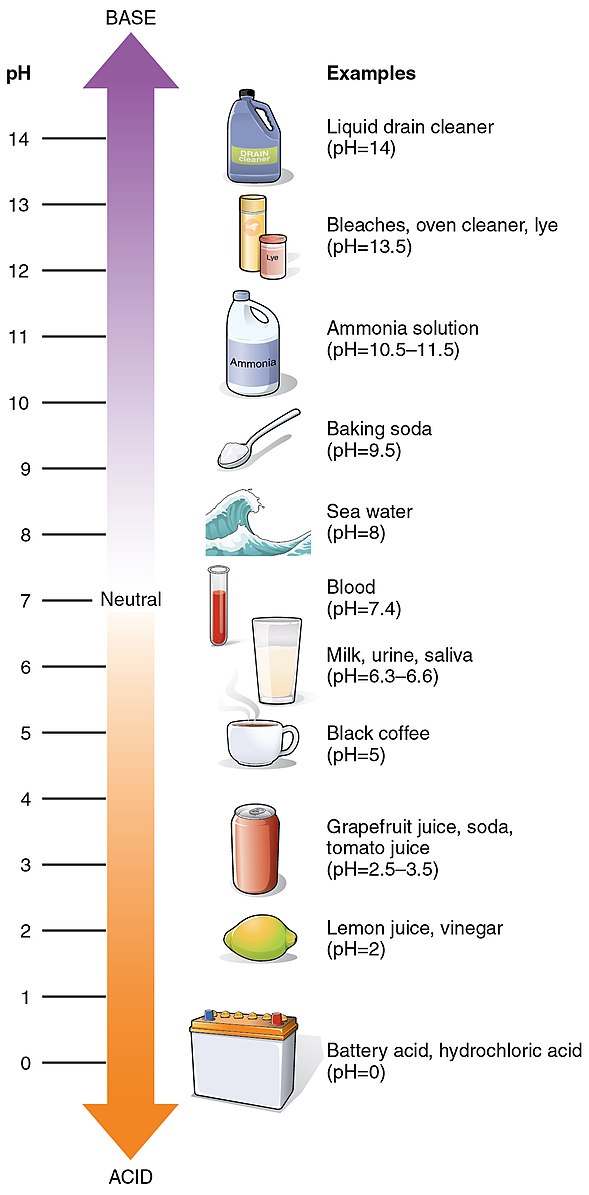The pH value of ammonium iodide (NH4I) in water is between 4.5 and 6.5. This range is due to the dissociation of ammonium iodide into ammonium (NH4+) and iodide (I-) ions, with the ammonium ion further dissociating to produce ammonia (NH3) and a hydrogen ion (H+), which lowers the pH of the solution.
Understanding the pH of Ammonium Iodide in Water
When ammonium iodide is dissolved in water, it dissociates into the following ions:
NH4I → NH4+ + I-
The ammonium ion (NH4+) can then further dissociate to produce ammonia (NH3) and a hydrogen ion (H+):
NH4+ ⇌ NH3 + H+
This reaction releases hydrogen ions (H+) into the solution, which lowers the pH. The pH of the solution will depend on the concentration of these ions and the equilibrium between them.
Factors Affecting the pH of Ammonium Iodide in Water
 Image source: OpenStax College
Image source: OpenStax College
The pH of an ammonium iodide solution can be influenced by several factors:
-
Concentration of Ammonium Iodide: The higher the concentration of ammonium iodide in the solution, the more hydrogen ions (H+) will be produced, resulting in a lower pH.
-
Temperature: The dissociation of ammonium iodide and the subsequent production of hydrogen ions are temperature-dependent. Higher temperatures can shift the equilibrium, leading to a lower pH.
-
Presence of Other Ions: The presence of other ions in the solution, such as hydroxide (OH-) or other buffers, can affect the pH by shifting the equilibrium between the ammonium, ammonia, and hydrogen ions.
Measuring the pH of Ammonium Iodide in Water
To measure the pH of an ammonium iodide solution, you can use a pH meter or pH test strips. The pH meter is the more accurate method, as it provides a precise numerical value for the pH. pH test strips, on the other hand, offer a more qualitative assessment of the pH range.
When measuring the pH, it is essential to follow the manufacturer’s instructions for the specific pH meter or test strips being used. This includes calibrating the equipment, ensuring the solution is at the appropriate temperature, and allowing sufficient time for the measurement to stabilize.
Adjusting the pH of Ammonium Iodide in Water
If the pH of an ammonium iodide solution needs to be adjusted, you can add a base, such as sodium hydroxide (NaOH) or potassium hydroxide (KOH), to raise the pH. Conversely, adding an acid, such as hydrochloric acid (HCl), can lower the pH.
When adjusting the pH, it is crucial to add the base or acid slowly and carefully, monitoring the pH regularly to prevent overshooting the desired pH. Sudden changes in pH can have adverse effects on the solution and any organisms or systems it may interact with.
Potential Contaminants in Ammonium Iodide Solutions
Ammonium iodide solutions may contain trace amounts of various heavy metals and anions, including:
| Contaminant | Typical Concentration Limit |
|---|---|
| Barium (Ba) | < 10 ppm |
| Calcium (Ca) | < 50 ppm |
| Cadmium (Cd) | < 0.1 ppm |
| Cobalt (Co) | < 1 ppm |
| Chromium (Cr) | < 1 ppm |
| Copper (Cu) | < 1 ppm |
| Iron (Fe) | < 10 ppm |
| Magnesium (Mg) | < 50 ppm |
| Manganese (Mn) | < 1 ppm |
| Sodium (Na) | < 50 ppm |
| Nickel (Ni) | < 1 ppm |
| Lead (Pb) | < 1 ppm |
| Zinc (Zn) | < 5 ppm |
| Chloride (Cl-) | < 100 ppm |
| Bromide (Br-) | < 100 ppm |
| Sulfate (SO4) | < 100 ppm |
| Phosphate (PO4) | < 10 ppm |
It is essential to follow proper disposal guidelines for chemical waste to prevent environmental contamination when working with ammonium iodide solutions.
Conclusion
The pH of ammonium iodide in water is typically between 4.5 and 6.5, due to the dissociation of ammonium iodide and the subsequent production of hydrogen ions. Factors such as concentration, temperature, and the presence of other ions can affect the pH of the solution. When working with ammonium iodide, it is crucial to measure and adjust the pH as needed, while also being aware of potential contaminants and following proper disposal guidelines.
References:
– YouTube Video on Ammonium Iodide pH
– Ammonium Iodide Product Specifications
– Calculating the pH of Ammonium Iodide Solution
– Homework Explanation on Ammonium Iodide pH
